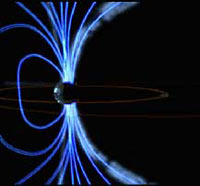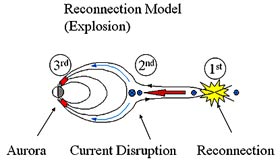UC Berkeley Press Release
THEMIS mission identifies power behind northern lights
BERKELEY — A year and a half after the launch of a fleet of five satellites to probe storms in the Earth's magnetic shield, scientists have accomplished the mission's primary objective: to identify the mechanism that triggers substorms in space.
 THEMIS observations confirm for the first time that magnetic reconnection in the Earth's magnetotail triggers the onset of activity in the auroras, putting a shimmer in the colorful curtain of the northern and southern lights. (NASA/Goddard Space Flight Center Conceptual Image Lab) |
Such storms can wreak havoc on satellites, power grids, and communications systems, and lead to the explosive release of energy that causes the spectacular brightening of the aurora borealis, or northern lights.
"We discovered what makes the northern lights dance," said Vassilis Angelopoulos of the University of California, Los Angeles, and principal investigator for the mission, called Time History of Events and Macroscale Interactions during Substorms (THEMIS).
In a report published online July 24 in Science Express, UC Berkeley, UCLA and NASA scientists report that the event triggering substorms in the magnetosphere surrounding the Earth originate deep in the planet's shadow, about a third of the way to the moon. There, magnetic field lines snap, reconnect and unleash a storm of energy that funnels to the poles and makes the atmosphere glow in reds and greens.
The findings will appear in print August 14 in the journal Science.
Competing theories
For 30 years, there have been two competing theories to explain the onset of substorms in the Earth's magnetosphere, said Angelopoulos, a UCLA professor of earth and space sciences and an affiliate of UC Berkeley's Space Sciences Laboratory, which manages the THEMIS mission.
One theory is that the trigger happens relatively close to Earth, about one-sixth the distance to the moon. According to this "current disruption" model, the solar wind causes large currents to build up in space carried by a "plasma" of charged ions and electrons. Sudden disruption of these currents by an explosive instability can cause them to short circuit through auroral currents, initiating a substorm.
A second theory says that the trigger is farther out from Earth, about one-third the distance to the moon, and involves a process called magnetic reconnection. This takes place in the Earth's magnetic tail between anti-parallel magnetic field lines originating from the northern and southern polar regions.
"As they capture and store energy from the solar wind, the Earth's magnetic field lines stretch far out into space. Magnetic reconnection releases the energy stored within these stretched magnetic field lines, flinging charged particles back toward the Earth's atmosphere, where they create halos of shimmering aurora circling the northern and southern poles," said THEMIS Project Scientist David Sibeck of NASA's Goddard Space Flight Center in Greenbelt, Md.
"Our data show clearly and for the first time that magnetic reconnection is the trigger," Angelopoulos said. "Reconnection results in a slingshot acceleration of waves and plasma along magnetic field lines lighting up the aurora underneath even before the near-Earth space has had a chance to respond. We are providing the evidence that this is happening."
Substorms are bursts of light and movement in the aurora. They produce dynamic changes in the magnificent auroral displays seen near Earth's northern and southern magnetic poles. These changes transform auroral displays into auroral eruptions. Substorms often accompany intense space storms that can disrupt radio communications and global positioning system (GPS) signals, cause power outages, and dump energetic particles into the Van Allen radiation belts that encircle the Earth. Solving the mystery of where, when and how substorms occur will allow scientists to construct more realistic substorm models and better predict a magnetic storm's intensity and effects.
'The sweet spot of the magnetosphere'
According to UC Berkeley space physicist Stephen Mende, the critical event for unlocking the mystery of substorm initiation occurred Feb. 26, 2008, when "the satellites were all in the sweet spot of the magnetosphere" where they recorded plasma density and flow, and electric and magnetic field data that clinched the issue. Although two other events since then appear to confirm the conclusion that substorms originate in a region of magnetic reconnection, "clearly we really need over the next winter to look at more cases," he said.
 Auroras occur when the magnetic field of the sun collides with that of the Earth, forcing Earth's magnetic field lines together, where they short circuit (see 1st) and reconnect with a whiplash effect that throws charged particles at the Earth. These particles funnel to Earth’s poles (3rd) and collide with the atmosphere, making the atmosphere glow in spectacular displays of light. Current disruption (2nd) occurs 3 minutes after reconnection. (NASA/Goddard Space Flight Center Conceptual Image Lab) |
The observations confirm for the first time that magnetic reconnection in the magnetotail triggers the onset of substorms, though researchers were surprised at the sequence of events after reconnection, Angelopoulos said. They found that, about 1.5 minutes after reconnection, the aurora brightened rapidly and expanded toward the poles, and then, 1.5 minutes after that, electrical currents flowing in near-Earth space were disrupted. Thus, current disruption is the last event of a substorm, not the first.
Previous studies of the Earth's magnetosphere and space weather have been unable to pinpoint the origin of substorms, which are the building blocks of larger storms.
"We need to understand this environment, and eventually be able to predict when these large energy releases will happen so astronauts can go inside their spacecraft and we can turn off critical systems on satellites so they will not be damaged," Angelopoulos said. "This has been exceedingly difficult in the past, because previous missions, which measured the plasma at one location, were unable to determine the origin of the large space storms. To resolve this question properly requires correlations and signal timing at multiple locations. This is precisely what was missing until now."
Mende hopes that further observations by THEMIS will reveal details of how the energy is released when magnetic reconnection is triggered, and how the magnetic field lines hold the energy derived from the solar wind until its spectacular release in the substorm.
THEMIS's five satellites
THEMIS has five satellites — each equipped with electric, magnetic, ion and electron detectors — in carefully chosen orbits around the Earth. An array of 20 ground observatories with automated, all-sky cameras, located in the northern United States and northern Canada, catch substorms as they happen, taking images of the aurora in white light. One satellite orbits one-third of the distance from the Earth to the moon, another about one-fourth the distance, and the remaining three about one-sixth the distance. The outermost satellite takes four days to orbit the Earth, while the next closest one takes two days, and the closest three orbits Earth in just one day. Every four days, all five satellites line up.
When the satellites are optimally aligned to measure the magnetic and electric fields of the plasma above the Earth's atmosphere once every four days, the ground-based observatories image the auroral lights and the magnetic field generated by the electrical currents that power the aurora.
THEMIS was launched on Feb. 17, 2007, from Cape Canaveral, Fla., and is expected to observe approximately 30 substorms in its nominal lifetime.
"Armed with this knowledge, we are not only putting to rest age-old questions about the origin of the spectacular auroral eruptions, but we will also be able to provide statistics on substorm evolution and model its effects on space weather," Angelopoulos said.
Other authors of the Science paper are James P. McFadden, Davin Larson, Charles W. Carlson, Harald Frey and Tai Phan of UC Berkeley's Space Sciences Laboratory; Karl-Heinz Glassmeier and Uli Auster of the Technische Universitšt in Braunschweig, Germany; Eric Donovan of the University of Calgary, Canada; Ian R. Mann and I. Jonathan Rae of the University of Alberta in Edmonton, Alberta, Canada; Christopher T. Russell, UCLA professor of geophysics and space physics; Andrei Runov and Xu-Zhi Zhou of UCLA; and Larry Kepko of the University of New Hampshire in Durham.
Links:

